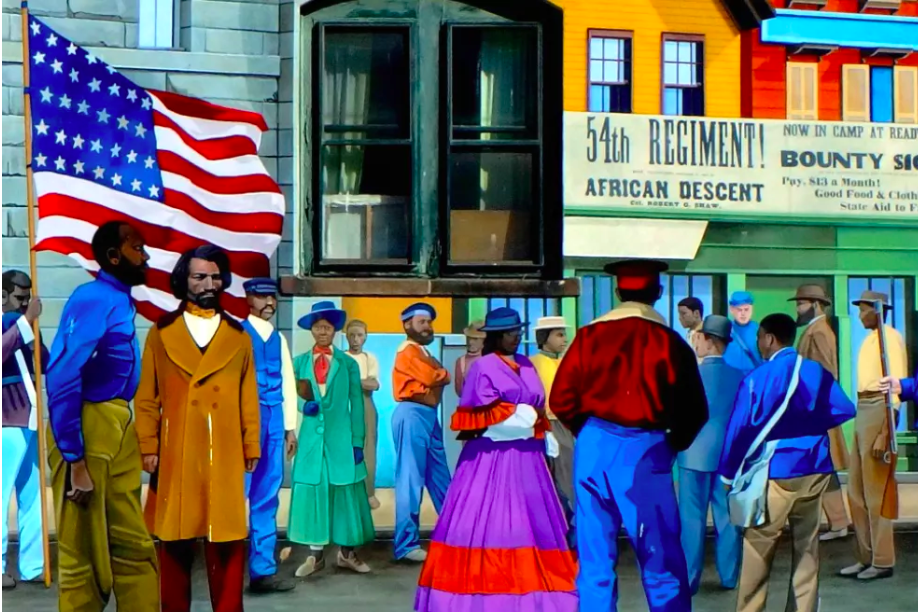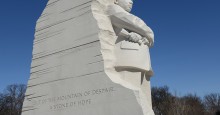
Mural of volunteer infantry on Williams Street, New Bedford, MA
February celebrations of Black History Month are especially meaningful through National Park Service programs and attractions.
Treat yourself to an immersive experience and fascinating celebration of Black History Month with activities featured in parks and monuments throughout the US. The National Park Service is preparing new and updated attractions in hundreds of locations across the country with exhibits, interactive learning, things to do and itineraries to enhance your trip.
“More than 400 years of Black history and heritage—including achievements, contributions, and historical journeys—are remembered and commemorated in places preserved for current and future generations.” according to the NPS interactive site.
The 28 days of Black History web page has park visit itineraries, downloadable resources, suggestions for discussion, and virtual tours on this excellent, interactive site. Pre-visit materials, films and activities such as coloring books for children to enjoy during travel are available for download. An interactive map helps to locate parks and attractions close to you.
Virtual history tours
Can’t get away? The National Park Service site has many virtual tours, films and learning materials to enhance Black History Month and enjoy from the comfort of your home or vehicle entertainment center.

Monument honoring Martin Luther King Jr. Washington DC
This month can become a meaningful and unforgettable experience for people of all ages with the features provided free at NPS.gov. A sampling of Black History Month park events and locations include:
• New Bedford Whaling National Historic Park (Massachusetts)
Once the economic center for an essential worldwide industry, many people are unaware that New Bedford also was a hub of abolitionist activities. As the center of much of the organization and support for the Underground Railroad, the whaling industry and citizens of the town welcomed, employed and sheltered escaped slaves.
Frederick Douglass located here after his escape from slavery and expanded his publishing and lecturing movement from New Bedford. The park is a rich experience at any time, where visitors can experience what travel was like “under sail” and the site preserves a sumptuous moment in history.
• National Capital Region (Washington DC)
Hear the stories and experience the long history of the people who built our nation’s capital, many of them enslaved.
Parks around Washington, DC are primed and ready with fascinating exhibits this month, including a recent park completely dedicated to showcasing the black experience in the US: The Smithsonian National Museum of Black History & Culture.
Learn about Harriet Tubman, the most famous “conductor” on the Underground Railway, who led hundreds of slaves to freedom. After escaping herself, she returned many times to lead groups of escaping enslaved peoples north by “following the drinking gourd” (the North Star), hundreds of miles by foot to safe havens and new lives where slavery was outlawed.
Learn Tubman’s story and those of other courageous black women at the fabulous exhibits at the National Museum of Black History & Culture in Washington, DC.
• Pullman National Monument (Chicago, Illinois)
The historic railroad manufacturing town actively sought black workers at the industrial plant–one of the only industries to do so. Railroad porters and waiters supported luxury railroad cars which traveled transport lines around the world.
The monument also is the site of an early mass struggle for labor justice. It also became one of the worst and costliest labor conflicts in our history, when panicked police shot hundreds of strikers.
Explore “Pullman Sleepers” and industrial railroad displays that encourage visitors to imagine life for the black workers who served the white-only passengers. Walk through the charmingly preserved streets with buildings retained as a time-capsule from the 1800’s, visit museums and interactive experiences in the town's many period buildings, enjoy murals and public works of art commemorating the struggle for justice for workers of any color.
Visitors can take virtual tours and download related resources.
• Tuskegee Institute National Historic Site (Alabama)
Booker T. Washington went from an enslaved boy to founding a university and learning center “…where all Americans can learn to succeed” as stated on the park website.
While there, check out exhibits about the heroic “Tuskegee Airmen” pilots of WWII and the ground-breaking laboratory of Dr. George Washington Carver. Ever wonder how the plastic materials in your vehicle came to be invented, drink a beverage made from nuts, or use “coffee creamer” to help wake you up on that long journey?
Thank Dr. Carver, who transformed the farming economy of the nation by developing marketable products from locally grown crops. Check out the many attractions at Tuskegee and be awed at the variety and the ongoing impact of these American lives.
• Booker T. Washington National Monument in Virginia
Watch the film “Measure of a Man” on the website to learn more of the story of the life that went “up from slavery” to founding the university whose world-wide influence endures to this day. Visitors experience the truth that horrendous situations are possible to overcome and immense goals are able to be achieved by the example of this American hero.
• New Orleans Jazz National Historic Site (Louisiana)
Sounds from this region changed the music of the world forever. Musical style descendants from this area, where cultures, rivers and oceans meet, continue today in the ongoing trends of blues, jazz, rock & roll, gospel, doo-wop, rhythm & blues, hip-hop and many others. Concerts, stories, river boat trips, films and performances are ongoing this month at many sites in the area.
• The Buffalo Soldiers (Yosemite NP, California; Yellowstone NP, Wyoming; Volcano NP, Hawaii)
When first set aside by President Abraham Lincoln, National Parks had no park service, police staff or rangers for many decades. The US Army was detailed to provide patrolling and assist visitors to “America’s great idea,” the first national parks in the world.
The job was assigned to several army corps consisting of black men, who were called “buffalo soldiers” by the indigenous peoples and new settlers of the American west. These battalions of calvary were well-known for their courage, effectiveness and dignity, secured through many difficulties and roadblocks when opportunities for black men to serve their country were almost non-existent.
• Lewis and Clark National Park (Fort Klatsop, Oregon & Washington)
The Corps of Discovery that President Jefferson commissioned to traverse the newly-bought Louisiana Purchase, consisting of half the present United States, included York, an enslaved black man.
The President sent this group of men to map the land, begin friendly relations with the native groups and plot routes for trade. York was a vital part of the Corps; he doctored the sick, hunted for food, scouted the land and assumed many responsibilities that would not have been allowed him in his native Kentucky.
The park, which occupies the site on the Pacific Ocean where the Corps waited out a winter before returning, features exhibit and displays about York’s life and contribution to the exploration of the West.
Copyright © 2024 by Sensible Driver. All rights reserved.